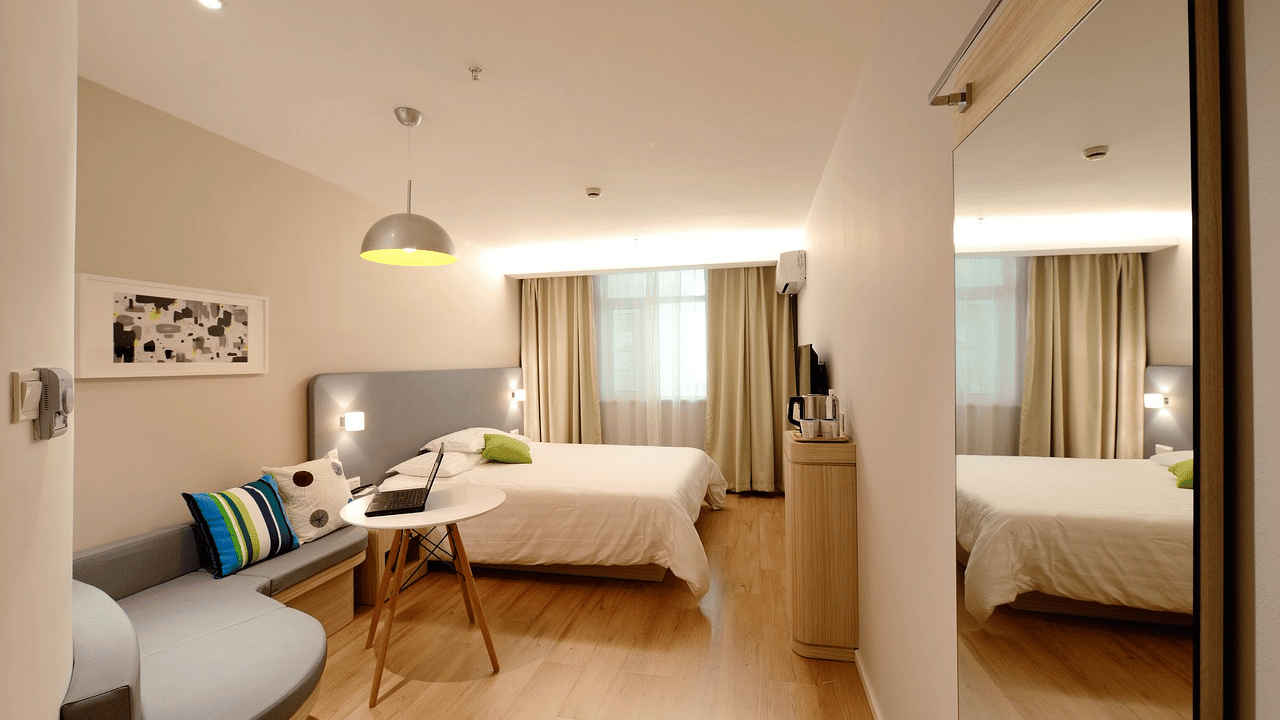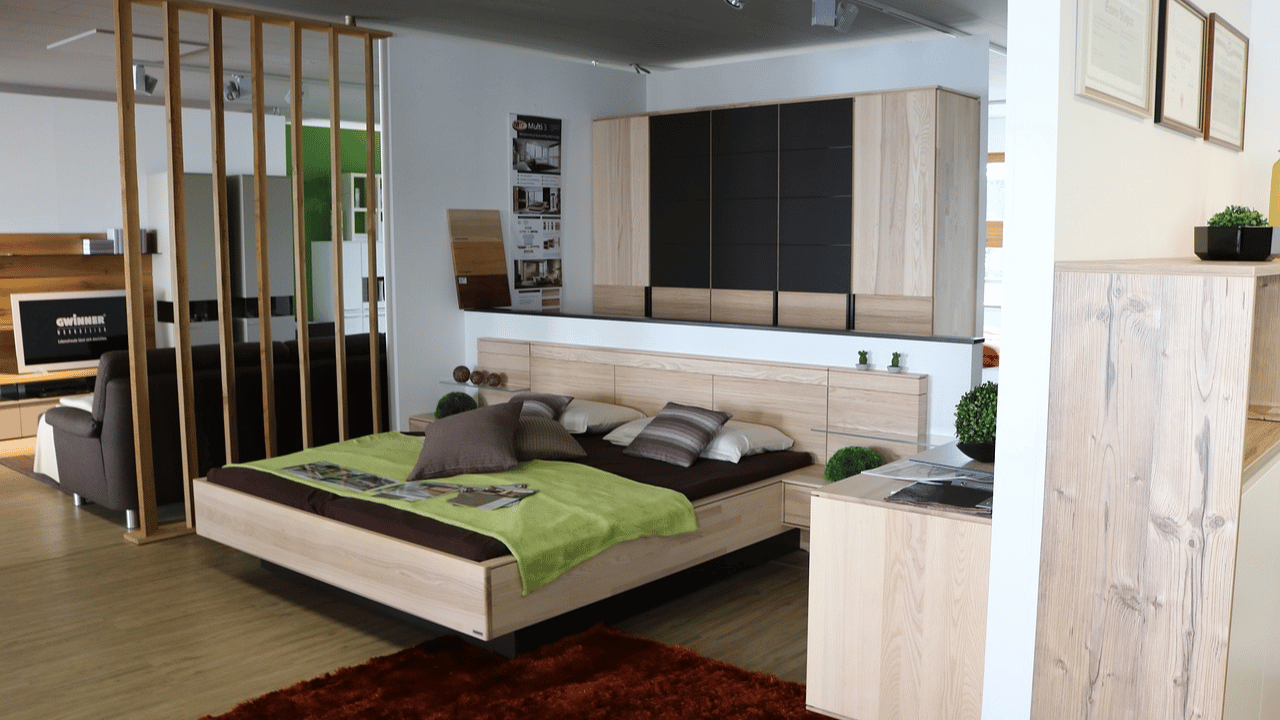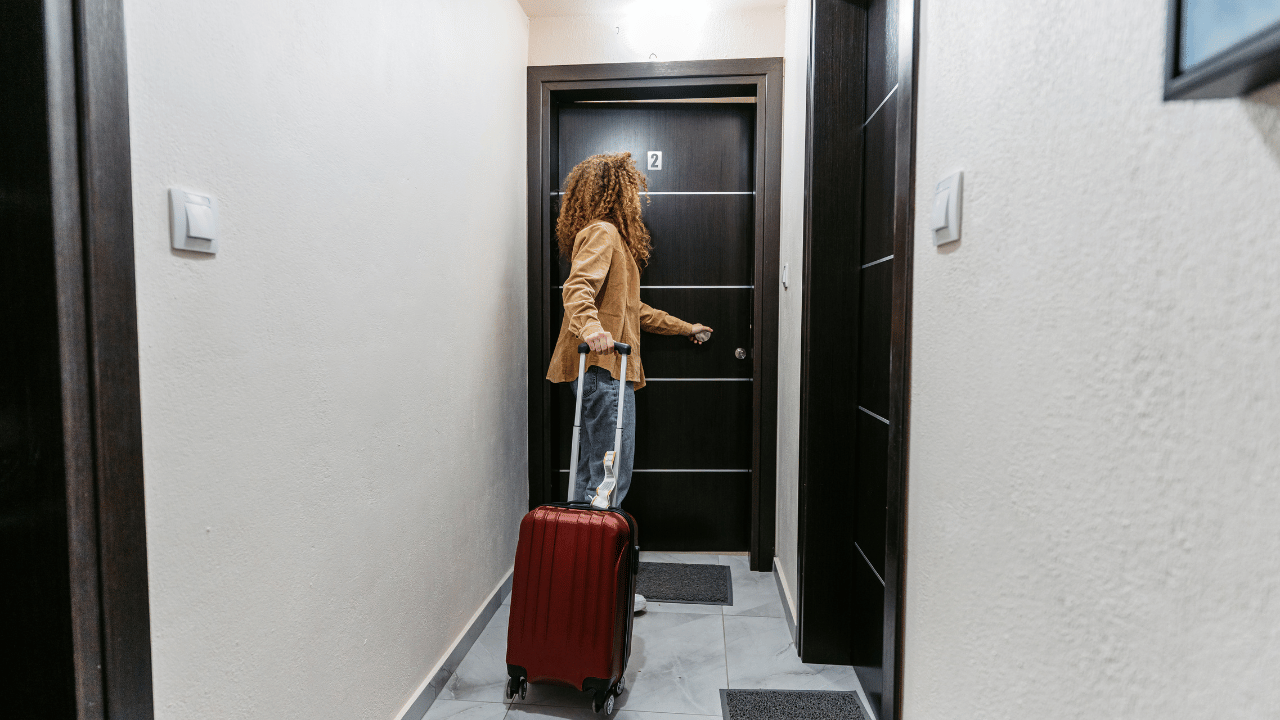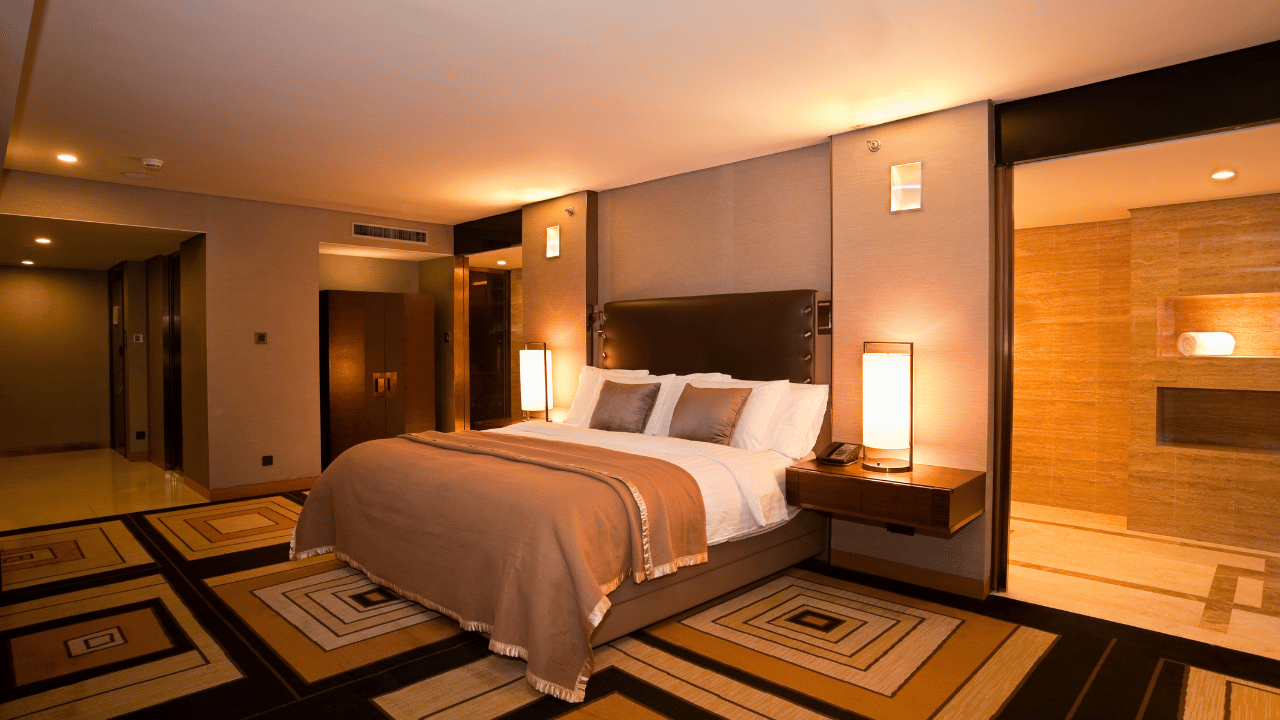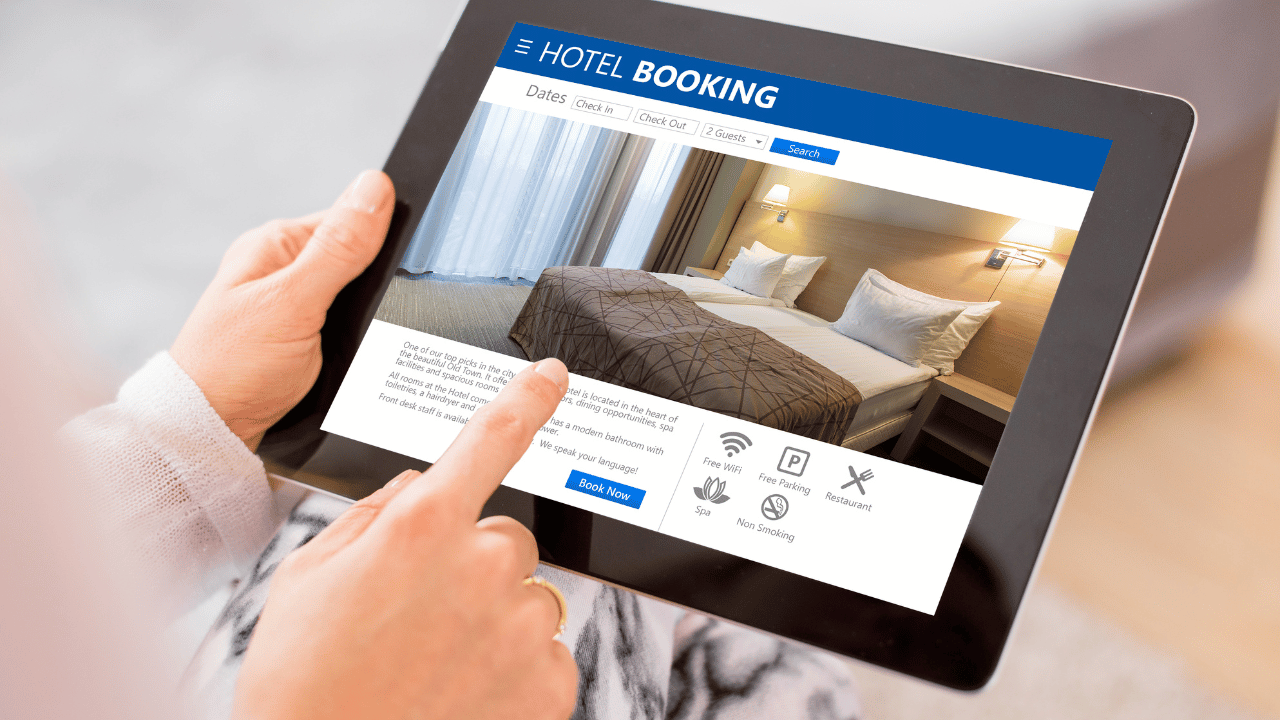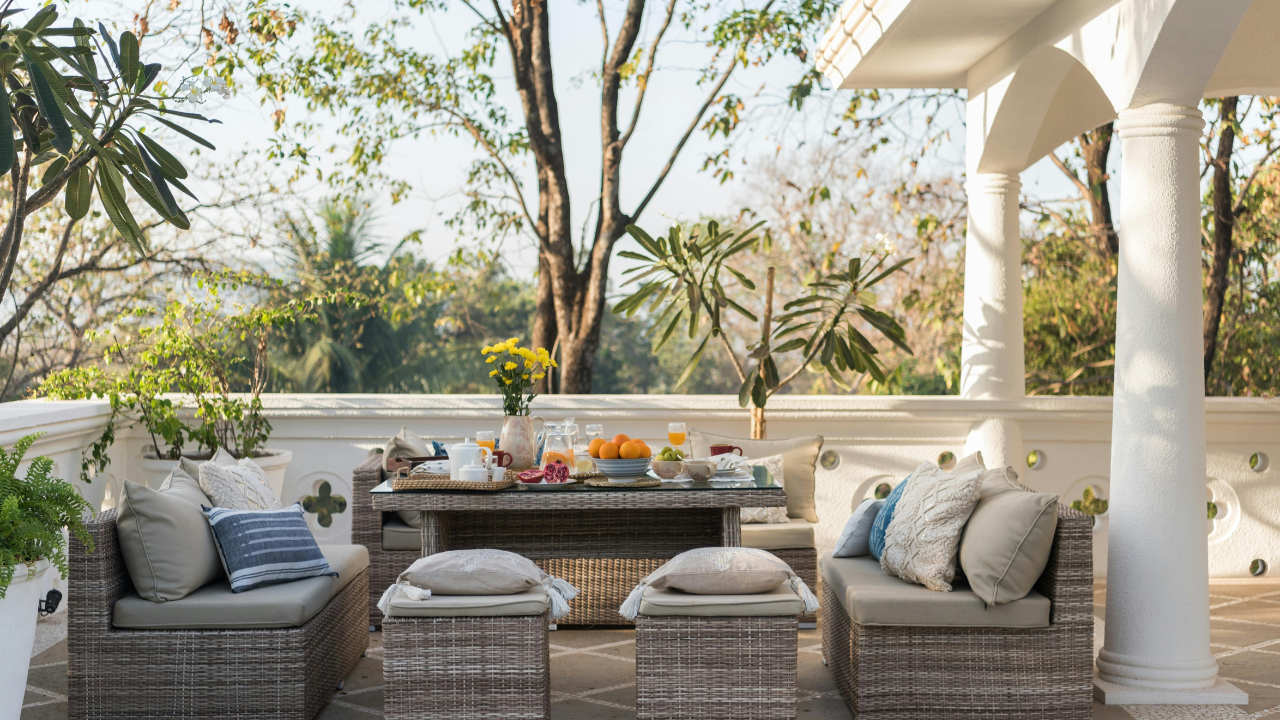CORE PRODUCT
What is a Double Room in a Hotel?
June 12, 2024 Justine. S
Share this post

A double room in a hotel typically refers to a room designed to accommodate two guests. Contrary to what the name might suggest, a double room does not necessarily feature two beds. Instead, it can come with one double bed or two single beds, catering to different preferences and needs.
Key Features of a Double Room:
- Occupancy: Designed for two guests.
- Bed Type: Usually one double bed or 2 beds that can be converted into a double bed.
- Layout: Varies by hotel but generally includes essential amenities like a bathroom, closet, and sometimes a seating area.
- Storage space: Wardrobes or closets are provided to store clothes and personal items as well as a “safe” for guest valuables.
- Workspace: Often includes a desk and chair for any work or planning activities.
- Other amenities: These can include televisions, minibars, and sometimes complimentary Wi-Fi.
In essence, a double room in a hotel provides a comfortable and convenient accommodation option for couples, friends, or solo travelers seeking shared lodging. Its versatility and suitability for various types of guests make it a cornerstone offering in the hospitality industry.
How Are Hotel Rooms Classified?
- Based on the number of beds;
- Based on the layout of the types of hotel rooms and the services offered,
- Based on the types of hotel rooms.
Why Should You Know About Room Types in a Hotel?
Why bother knowing about hotel room types? Well, it’s pretty straightforward. The types of rooms a hotel offers can make or break a guest’s decision to book.
It’s all about hitting the sweet spot between catering to your ideal guests and appealing to a wide audience to keep those rooms filled and your revenue up.
Hotels today are significantly enhancing their amenities by incorporating sophisticated hotel management software. They ensure a warm welcome for a broad spectrum of guests—from single travelers and couples to families and business travelers. They offer room choices like singles, doubles, queens, and suites to suit everyone’s needs.
Keep reading as we unpack the different hotel room types below.
What Are The Types of Hotel Rooms?
Hotel rooms are categorized based on various criteria, including occupancy capacity, the type and number of beds, amenities offered, the room’s design or layout, any unique features, and the overall level of luxury.
This classification system helps guests know precisely what they’re booking for their stay. However, the specific names, categories, and dimensions of rooms can vary across hotels depending on their classification and intended audience.
Here are some common types of hotel rooms that are found in most hotels, such as:
Hotel Room Types by Occupancy
1. Single room
A single room is designed for one occupant and can contain either a twin bed or a double bed. Generally, hotels offer different pricing for single rooms equipped with a twin bed versus those with a double bed, despite both accommodating only one guest.
2. Double room
A double room is a type of hotel accommodation designed for two people. It typically features a single double bed, but options with two twin beds are also common. This flexibility is convenient for a variety of travelers, such as friends, couples, or colleagues on a trip, who might prefer not to share a single bed yet wish to avoid the cost of booking separate accommodations. The size of a double room can vary, which may influence the price of the stay.
3. Triple Room
This type of room accommodates three guests. It can feature different sleeping arrangements such as three single beds, one double and one single bed, or two double beds to suit the needs of the occupants.
4. Quad Room
A quad room is designed for four occupants and typically contains two double beds. In some cases, accommodations may opt for a dormitory-style setup, utilizing bunk beds or single beds to make efficient use of space and cater to different group dynamics or preferences.
Hotel Rooms by Bed
As a hotelier, your approach to room classification by bed type is key, but equally important is establishing clear occupancy limits for each room. It’s important to communicate to your guests that a room’s bed size doesn’t dictate how many can stay overnight.
This clarity helps manage expectations and maintains safety and comfort standards. Consider setting straightforward policies for additional guests, including any extra charges or the option to include costs for rooms with an odd number of occupants. This not only upholds your hotel’s reputation for transparency but also ensures a pleasant stay for all guests.
Remember, your strategy in matching room types with occupancy policies directly impacts guest satisfaction and your hotel’s efficiency.
Here are some room types determined by bed availability:
- Queen Room: This room features one queen-size bed.
- King Room: Comes with a spacious king-size bed.
- Twin Room: Equipped with two beds
- Double-Double Room: This room is ideal for two to four people, such as a family with children. It includes two double beds and sometimes two queen-size beds.
- Studio Room: A versatile option, the studio includes a bed that can double as a couch and might also offer additional bedding. Studios can mimic fully-equipped apartments with a small kitchenette.
Hotel Rooms by Layout
‣ Standard Room:
This room is ideal for single travelers or couples. It features a double bed, typically similar to queen or single rooms.
‣ Deluxe Room:
A deluxe room in a hotel is an upgraded, more spacious room featuring superior amenities and decor. Key features include:
- Size: Larger than standard rooms.
- Bed: King or queen size with premium bedding.
- Amenities: Enhanced amenities such as a larger TV, luxury toiletries, and sometimes a mini-fridge or minibar.
- Furnishings: High-end furniture and decor, often with a seating area.
- View: Better views, often with balconies or terraces.
- Extras: Access to exclusive areas, advanced technology, and superior bathroom features like rain showers or bathtubs.
‣ Suite:
A hotel suite is a premium accommodation offering more space and luxury than standard rooms. Suites range from basic or executive suites with a living area and bedrooms to junior suites with combined sleeping and sitting areas, sometimes including a kitchenette. Presidential suites are the top tier, offering multiple bedrooms, living areas, and high-end amenities and services.
Key features include:
- Separate Living Area: Distinct from the bedroom.
- Bedroom: Typically a king or queen-size bed.
- Enhanced Amenities: Larger TV, minibar, coffee maker, luxury toiletries.
- Bathroom: Spacious with premium fixtures.
- Workspace: Dedicated area with a desk.
- Dining Area: Some have a separate dining space.
- Views: Premium views, often with balconies.
- Additional Services: Access to exclusive areas and enhanced services.
Suites provide extra space and comfort, ideal for families, business travelers, or special occasions.
‣ Connecting Room:
Features a door between rooms and separate exterior doors, convenient for families or groups preferring easy in-room access without using the hallway.
‣ Joint Room:
Also known as an adjoining room, this consists of two spaces sharing a common wall without a connecting door. It is suitable for families with older children who require nearby but separate rooms.
‣ Accessible Room:
Legally mandated, these rooms are wheelchair-friendly with specially equipped bathrooms for guests with disabilities.
‣ Apartment-style room:
Aimed at long-stay guests, these rooms offer full kitchens and laundry facilities, resembling apartment living with limited housekeeping.
Hotel Rooms by Amenities
Some hotel rooms break the mold with unique features:
Cabana: Ideal for properties with outdoor pools, cabana rooms offer direct pool access or come with a private pool. Perfect for guests seeking relaxation and convenience, these rooms enhance the boutique hotel experience and can be a key selling point for travelers who prioritize leisure and privacy.
Penthouse: For the ultimate in luxury, penthouse suites go above and beyond. Occupying the top floor, these rooms offer expansive spaces and are equipped with the very best amenities, all with a touch of exclusivity.
Villa: Villas represent a premium offering in the resort segment, appealing to families or groups seeking space, privacy, and the comforts of home. Equipped with multiple bedrooms, a living area, possibly a private pool, and a balcony, villas cater to the high-end market and can significantly increase your property’s appeal.
Pet-friendly room: A hotel may allow all or some rooms to accommodate certain types of pets or service animals.
Understanding and promoting these unique room types effectively can help you cater to niche markets, increase occupancy rates, and elevate your property’s reputation in the competitive hospitality industry.
How To Name Different Types of Hotel Rooms
Going beyond basic numerics and labels to name hotel room types plays an essential role in setting your property apart. It’s not just about offering a place to stay; it’s about creating an experience from the first click.
By giving rooms distinctive names, hotels invite guests into a story, enticing their imagination and offering them a taste of the experience before they even arrive. This approach not only differentiates your hotel but also deepens guest engagement, potentially turning a simple stay into a memorable journey.
1. Marketing Magic
Let’s be real, “Honeymoon Suite” sounds a whole lot more inviting than “Room 204,” doesn’t it? It’s not just a room; it’s an experience, promising romance and luxury. This is about marketing at its finest, where the name alone sets the expectation and targets the right audience.
Imagine a room called “Mountain Retreat Single” – the name clearly indicates what the guest will enjoy and who it’s best suited for.
2. Storytelling Starts Here
Ever noticed how people love to share unique experiences more than mundane ones? That’s where creative room names come into play. Staying in a room with a memorable name like “Sunset Suite” is not just a stay; it’s a story waiting to be told. And in today’s social media-driven world, who doesn’t want a stay that’s share-worthy?
3. Drive Up Those Dollars
It’s simple – unique sells. When guests book a room like “Tranquil Cabin Escape,” they’re expecting and willing to pay for something above the ordinary. This isn’t just about higher prices; it’s about creating value that guests are happy to pay for.
Because let’s face it, an adventure in “Tranquil Cabin Escape” sounds way more appealing than a night in “Room 208.”
But remember, creative names should not confuse your guests. Pair these creative room names with clear, descriptive details about the room. After all, your guests need to know what adventures await them behind their uniquely named doors.
Hotel Room Description Tips
Detail the amenities: Guests should understand the specifics of their booking, including the type of bed, room size, bathroom features, entertainment options, potential scenic views, and more.
Emphasize the room’s unique selling proposition: Does it cater specifically to family needs, offer a zen retreat for relaxation, function as a productivity nook, or serve as a sanctuary for romance? Ensuring guests understand the room’s tailored experience can make all the difference.
Add creativity to your descriptions. Crafting themes for each room not only captivates potential guests but also helps align their stay with their current desires or needs.
A picture is worth a thousand words: Pairing your descriptions with vivid, high-quality photographs reinforces the guests’ expectations and trust in what they are investing in.
Address potential queries proactively: To minimize uncertainties, ensure that accessibility features, details about cancellation policies, breakfast offerings, and policies on pets, children, and smoking are covered.
Top Tips for Offering Room Upgrades to Guests
Upselling guests to superior room categories isn’t just a win for your revenue—it’s a golden opportunity to turn their stay into a rewarding experience. Here are some insider tips for nailing that perfect upsell:
1. Show the Value Beyond the Price
Upselling is easy when you frame it as more bang for their buck. An offer that includes a free breakfast, a leisurely late checkout, or access to some luxurious resort facilities? Now, that’s a deal hard to resist because it’s not just about spending more; it’s about getting more.
Imagine this: As they’re browsing through their online check-in email via RoomRaccoon’s PMS, a tailored upgrade offer pops up: “How about a complimentary dinner basket and a room with a view?” It’s all there, just one click away.
This approach not only showcases the value of the upgrade but leverages the perfect moment when the excitement about their stay is at its peak. It’s less of a sales pitch and more of an invitation to enhance their experience, all while making the process as smooth and welcoming as their forthcoming stay.
2. Sell the Dream, Not the Room
It’s all about the story behind the upgrade. Is it a view that makes every morning unforgettable? Perhaps it’s the echoing comfort of an ultra-plush king-size bed that promises the sweetest dreams? Paint a picture that they can’t resist diving into.
3. Sweeten the Deal
Make upgrading seem like the best choice ever. “With this room, you also get to enjoy our exclusive breakfast for free.” Who doesn’t love free pancakes?
4. Make it Personal
Take a moment to get to know why they’re here. Is it a family adventure? Suggest connecting rooms as a game-changer for keeping the family together. Matching the upsell to their preferences makes all the difference.
5. Point Out What’s Special
Does your hotel offer something no one else does? Tell them! “Our hotel has this cozy rooftop garden you won’t find anywhere else in town.”
6. Empower Your Team
Last but absolutely not least, the magic really happens when your staff knows their stuff. From understanding every room category and its appeal to mastering the art of the offer—they’re your frontline in making those upsell moments count.
Remember, it’s about making guests feel like they’re getting an exclusive chance to enhance their stay. When you connect, personalize, and genuinely aim to give them an even better experience, you don’t just upsell; you create loyal guests who keep coming back for more.
How You Can Create Different Room Types with RoomRaccoon
1. Simplify room setup with RoomRaccoon’s room categories
RoomRaccoon’s property management system includes an easy-to-navigate “property module” designed to help you craft diverse room types to match your property’s distinct layout and features.
Within this module, you’ll find a category tab for setting up your various room categories illustrated above, this feature allows you to customize categories according to your property’s style and your personal preferences.
2. A room for every guest: Tailoring room types with RoomRaccoon.
In our “property module,” you’ll find the Room/Units tab, which is a fantastic feature. Here, you can easily create rooms by adding the name, room type, category, and number of occupants for each room type.
Once created, the room details and creation date are saved and can be edited at any time to suit your preferences. These rooms will be displayed in the reservations calendar and booking engine, providing a seamless integration for managing bookings.
Plus, our module accommodates the inclusion of ‘grey rooms,’ versatile spaces that can serve various functions such as notes, boardroom space, parking, or differentiating room categories. This functionality is activated simply by skipping the category selection. This feature offers you expanded control and customization of your property’s layout and services.
3. Create tailored add-ons to suit every guest
One of the perks of utilizing RoomRaccoon’s “property module” is the capability to incorporate “extras” – personalized additional options for each room category. This means whenever guests reserve a particular type of room, they can select from a curated list of extras to enhance their stay.
For example, suites might offer an “extra” option like “a bottle of champagne.” In fact, in our summer 2024 report, a selection of exceptional choices has been spotlighted that truly stand out. These include:
They include:
- Airport Shuttles
- Spa Treatment
- Picnic/ Dining Boxes
- Bottle of MCC/Wine
- Game Drives
- Breakfast
- Charcuterie boards
4. Revamp your hotel rates with RoomRaccoon’s rate plans
RoomRaccoon’s platform also includes a feature within our property module that enables the customization of rate plans for each type of room. By considering factors like room size, occupancy limits, and special amenities (e.g., free breakfast), hotels can set prices that are both dynamic and specific to each room’s offerings.
Plus, to optimize revenue, it’s advisable to create a pricing strategy that considers the demand for each type of room, seasonal fluctuations, and the competitive landscape. RoomRaccoon’s channel manager effortlessly does this for you.
On top of this, we recommend a solid revenue management strategy. This includes using a secure system for payments, like RaccoonPay, which makes the whole booking and paying process smooth and safe for you and your guests.
Pro tip: Implement dynamic pricing. This means changing your rates based on how popular your rooms are at the moment. It’s a win-win: you maximize earnings during busy seasons without leaving rooms empty when things slow down.
FAQ: What Should Hoteliers Know About Double Rooms?
1. Why do hotels charge different prices for rooms, and how do they sort their rooms into categories?
Hotels offer a variety of room rates to accommodate the diverse needs and preferences of their guests. While some guests might look for a simple and cost-effective room, others might seek out a luxurious and spacious suite.
Hotel rooms are classified based on attributes like their size, the type of bed provided, the amenities available, and the room’s view. This categorization enables hotels to present diverse rates and packages, appealing to a broad spectrum of guests.
2. How Do Hotel Rooms Differ?
Hotel room offerings can differ widely, influenced by factors such as the room category, the hotel’s brand, and its location. Major aspects where hotel rooms can vary include:
- Size of the Room: The square footage or layout can vary, providing different levels of comfort and space.
- Type of Bed: Choices range from single, queen, and king to twin beds, catering to different needs and preferences.
- Amenities Offered: These can range from basic to luxury, including things like minibars, kitchenettes, premium toiletries, and technology features.
- View and Location: The scenic outlook from the room and its specific location within the hotel (e.g., ground level vs. high floor, proximity to facilities).
- Price Point: Rooms with luxurious features and prime views are generally priced higher, while more economical options may offer basic facilities and less sought-after locations within the hotel.
3. How many people can stay in a double room?
A double room is designed for two people. However, some hotels may allow an extra bed or crib for an additional guest or child, often at an extra cost.
4. Are double rooms the same size in all hotels?
No, the size of double rooms can vary significantly between hotels. Some hotels offer spacious double rooms, while others may have more compact accommodations.
5. Is there a difference between a double room and a deluxe double room?
Yes, a deluxe double room typically offers more space and upgraded amenities compared to a standard double room. This can include better views, higher-quality furnishings, and additional services.
6. What is the difference between a double room and a twin room?
A double room usually has one double bed, while a twin room has two single beds. Both are designed to accommodate two guests.
Follow us
Justine. S
Justine is a Content Manager at RoomRaccoon. She brings her background in language and communication studies to the SaaS world. When she's not writing about the latest trends in the industry, she's probably out exploring the world or indulging in her love of coffee.
Related Posts
Subscribe to our newsletter for more on the latest hospitality & RoomRaccoon updates delivered straight to your inbox!








